The best puzzle games on PC
A very puzzling collection
We all love a bit of a headscratch sometimes - something to challenge the old noodle and vexate the little grey cells. Luckily, puzzle is a mainstay genre in video games, from classic point 'n' click adventures to weirdo physics puzzles and aliens in space. Puzzle games can also be RPGs or adventure games; they can have horror or hacking. There are so many, in fact, that curating a list of the best puzzle games is something of a puzzle in itself. But at RPS we like a challenge, so we've brought you a new and improved list of the 25 best puzzle games on PC that out there today.
We've got everything a puzzle-head might want: sokoban games, murder mysteries, strategy, physics, jigsaws, goo, and that one Jonathan Blow made. Puzzles are a broad church, after all. Best of all is that all of these are playable and ready to go, so there's no mucking about with emulators. We'll keep the list updated with the new best and brightest puzzle games, too, so check back every so often. Scroll down to read them all, or click a name that takes your fancy in the list below.
The best puzzle games on PC
- Unpacking
- Jigsaw Puzzle Dreams
- How To Say Goodbye
- Stephen's Sausage Roll
- The Room 4: Old Sins
- The White Door
- Gorogoa
- Inside
- The Case Of The Golden Idol
- Mini Motorways
- Patrick's Parabox
- Knotwords
- Dorfromantik
- The Looker
- Baba Is You
- Return To Monkey Island
- Opus Magnum
- The Talos Principle
- Ctrl Alt Ego
- World Of Goo
- Unavowed
- The Witness
- Portal
- Outer Wilds
- Return Of The Obra Dinn
25. Unpacking
There may be some among you who object to Unpacking being classified as a puzzle game, and to those people I say: Boo! Boo to you! It's not the kind of headscratcher that'll see you rage-quitting a level until you've calmed down enough to have another go at it, but the challenge - to unpack and put away a person's possessions as they move to different homes throughout their life - is a puzzle. It's possible to get it wrong. As you open the brown boxes and pull things out of the rustling paper, you understand that it would not do to put the tooth paste in the kitchen. That goes in the bathroom, along with your towels and shampoo. If, once you've emptied all the boxes, some things aren't where they're meant to be, their outline will glow until you make room somewhere more appropriate. A ladle does not belong in the bedroom.
Part of the puzzle is fitting your things around the possessions of people you live with. If you move in with housemates, one of whom is making a Sailor Moon cosplay dress, there isn't much space in the living room. One level in particular broke my heart, as you have to find the right place to put your framed art degree once you move in with a new boyfriend. Unpacking isn't a puzzle like doing the cryptic crossword is. Unpacking is a puzzle like real life is.
24. Jigsaw Puzzle Dreams

Taking things to a very literal place, Jigsaw Puzzle Dreams is, indeed, a space to do virtual puzzles of the jigsaw variety. I'm normally suspicious of jigsaw games, as they're usually a selection of 2D pictures of anime girls lazily cut up into repeating pieces. Jigsaw Puzzle dreams is the luxe version. Each piece of the puzzle is a 3D object with its own physics, so you can turn them around, pick them up, drop them, and potentially lose them under the table (although there's a button to zoom lost pieces back to you).
You sit and do your puzzle in a small flat, with several areas to choose from where you can sit and pick through your jigsaw like an ape grooming a compatriot. You can customise not only the furniture, floors and walls of your imaginary flat, but also the number of pieces your jigsaw will have (I'm currently still working my way through through a six thousand piece jigsaw of a slice of cake that I've been doing for about a year). And you can upload your own pictures to turn into jigsaws to, if you really want some anime girls.
23. How To Say Goodbye

This is sort of a sokoban, except you move the scenery around, and that allows you to move the characters. As a whole, the game tells the story of a recently-dead ghost, lost and disorientated in a land of the dead populated by simiarly disorientated spirits. The goal is to help these spirits move on, by solving the grid puzzles in levels to let them escape the purgatory world they're in. Each level has a door to escape through, but you might need to press buttons, find keys and avoid desperate Spleen ghosts. Many levels have several steps, and it'll take you a while to get the hang of how you can move things to you, rather than going to them. It's a twist on a familiar formula that will surprise you with how hard it can be.
The art is colourful and streamlined, inspired by children's picture books. It gives everything an appropriately unreal quality as you pull and push ghosts and obstacles around on the conveyor belt floors of the levels. And the levels themselves fit with that vibe. They're downright whimisical, from gardens, to messy kitchens, to the actual moon. But with the whimsy you also get a quiet story about grief and moving on. A lot to pack in one game.
22. Stephen’s Sausage Roll

Speaking of sokoban games, let me invite you to cook a sausage. Stephen's Sausage Roll was an instant classic when it came out. You, a small person, have a giant fork, with which you may roll giant fat sausages onto grills to cook them. Each sausage has four sides, (top left, bottom left, top right, bottom right), and each must be rolled onto a grill square on the floor once to be cooked to perfection. But grillmaster beware, for if a bit of saus is grilled more than once, well then you've got yourself a burnt sausage. And that won't do at all.
The levels in Stephen's Sausage Roll feel small even as they grown large and increasingly complex. Rarely do you have enough room that you feel you saft to turn around without knocking into a sausage that you had oh-so-carefully manoeuvred into the right position. Your roasting fork takes up a whole square in front of you, so mistakes are easily made - but that's part of the fun with a game like Stephen's Sausage Roll. Resetting a level is easy, and there'll be many a time that you successfully cooked two out of three sausages before you realised you biffed a move crucial in allowing you to get the final bit of the final saus done. It's a simple, delicious and infuriating puzzle game.
21. The Room 4: Old Sins

The Room series always sees you, the unknown player character, lured to an isolated area full of complex puzzles that you have to solve. The very first Room was a room - an attic, in fact, and The Room 4 goes back to the attic. This time you're confronted with a very detailed dollhouse of a mansion, which turns out to be a model of the mansion you're in. The model is itself partly a puzzle box, with moving cogs and sections that open up as you interact with it, but it also, as you open up access to the different rooms, is a kind of magic portal to full-sized versions of said rooms. Inside these rooms are more puzzles.
The Room 4 is full of so many lovely machines: polished wood with hidden doors, polished cogs, sliding coloured pieces and buttons, and they all feel intricate and tactile, and like they were made by a craftsman. But there's a dark, almost Lovecraftian layer to The Room 4 as well, with many puzzles requiring the use of a magical eyepiece to see runes and symbols instrumental to understanding the solutions. There are tentacles. Old Sins is the most complicated but most satisfying of all the Room games yet.
20. The White Door
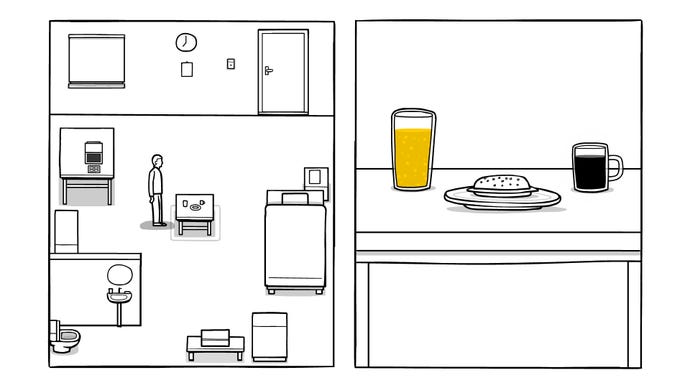
Not all puzzle games have to be maxi. The White Door is one of the more recent entries in the Rusty Lake series of 2D puzzle games, and is arguably the most minimalist. You control an amnesiac in what appears to be some kind of hospital room, where each day is planned out to a strict schedule. The game doesn't tell you this, of course, but the schedule is pinned to the wall for you to find. A nurse comes in to ask you questions: what's today's date?; how old are you?; where do you work? And you have to find the answers to these questions around the room. Subtle things change. You can see someone standing in the distance outside the window.
Every night you dream of events in your past, and can use them to untangle the events that brought you to this room in the first place. It's a short, spare game with nothing wasted. A locked room mystery with a twist.
19. Gorogoa

Gorogoa was designed for touchscreens, but you're not losing much at all when you play it on PC. The screen is divided into quarters, and you can zoom in and move them around to create new paths for the boy traversing them, letting him move from one to another by clearing a path in one section. You can even layer them on top of one another, putting a doorway in one frame over the top of the boy in another, so he can step through. At other times the panels becomes a kind of jigsaw that requires you to zoom in and out until you find the right perspective to match things up. You might need to place a fire under a steam cooker, or weight a shelf so it tips the right way.
This all plays out in beautiful 2D animations, and without any actual instructions. Gorogoa is fantastic and letting you experiment, sometimes nudging you the right way with some pictograms, but for the most part just letting you explore its living, moving world. It's both beautiful and innovative, in a way not many games of any genre manage, let alone puzzle games.
18. Inside

PlayDead's creepy, monochrome side-scrolling puzzle-platformer Limbo rightly caused a stir when it was released, because nobody had seen anything quite like it before. PlayDead managed to build on Limbo with Inside. Though Inside has a lot of similarities - a side on puzzle-platformer with a small, vulnerable protagonist, and dark themes - but it takes both it's ambient storytelling and how it plays to new heights. Inside's protagonist is a young boy who you join in the middle of being chased through a forest. The journey progresses through decreasingly rural areas, then through a weird science facility full of what appear to be mind controlled zombies and various human experiments. The ending is famously, er, surprising.
The puzzles themselves are a mix of logic applied to physics (put box a here and activate switch b to precipitate effect c) in surprising ways, and you can die in similar physics based ways that have quite graphic animations. But there are also puzzles that you solve by paying attention to the game world. One of the more memorable moments is having to disguise yourself in a line on shambling zombies by mimicking their movements at the right time. I don't know if that counts as a puzzle, exactly, but it's bloody good.
17. The Case Of The Golden Idol

The Case Of The Golden Idol is a point and click detective game that strips out all the extraneous bullshit like walking around and talking to characters, so the time you save there can be redistributed to furiously staring at word bubbles. The Case Of The Golden Idol spans many decades in the lives of a couple of posh weirdos and their family and associates, all centering on the titular artifact. Every few years there are some (or several) murders relating to it, and you get to see them in a snapshot moment - either the moment the murder is committed or as the body is discovered - with the characters, scene and items all frozen.
By clicking around the scene you can investigate the contents of rooms, pockets and even brains, sorting through diaries and weapons and piecing together what happened. To solve each leve you'll need to identify who died, whodunnit, and what they dunnit with, but there are also optional tasks. At a dinner party where someone was poisoned you need to work out who was sitting where, but you can also figure out which of the servants' rooms belong to which servant. In one memorable level at a mansion, more than one person is on a different sort of drug. To fill in these answers you're provided with nouns and verbs to slot into sentences with gaps, and you can only move on when you get it right. It's difficult, but it's very worth it.
16. Mini Motorways
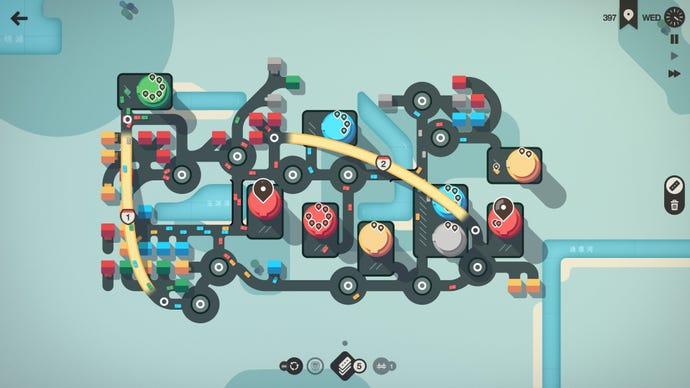
Have you ever been stuck in traffic commuting and thought, "what absolute fool designed this?" Now, thanks to Mini Motorways, that absolute fool can be you! The idea is to plan the road system of a city, getting people from their houses to where they need to be and back again, as efficiently as possible. The cities grow as the game goes on, so your roadways get more complicated, and you can put in things like roudabouts, motorways and traffic lights to keep things organised, but you have a limited number of these, as well as limited road tiles.
Houses, the population centres of your city, and workplaces keep mushrooming up across the confined map area, and they're colour-coded. A yellow workplace might appear next to a bunch of blue homes, while the yellow population density is mostly on the other side of the river. Junctions slow down traffic, so if you can put in roundabouts it all flows better, but roundabouts take up a lot of space. Maybe a motorway would help ease the congestion, but it might back up traffic either end. Mini Motorways is a continuous puzzle, in other words, and one that only gets harder the better you are at it.
15. Patrick's Parabox

The ouroboros is the ol' famous endless snake eating it's own tail thing. Patrick's Parabox is a bunch of boxes inside boxes, boxes eating eachother recursively, with puzzles inside. It's technically a sokoban game - you have to push boxes into the right places, and if you push them against a wall you can't pull them out. But you can push boxes (and yourself) into other boxes that have openings. These boxes themselves contain shapes that you can use to traverse and solve the puzzle outside the box. You have to think in boxes.
There are 350 hand-designed puzzles in this mind melter of a game, and Patrick's Parabox does a good job of teaching you the fundamentals of its rules so you can tackle more advanced puzzles. You can transport boxes inside boxes. You can put a box inside itself and start thinking in infinity. Multiple boxes can be stacked inside other boxes, like nesting dolls. Look, this game has a lot of boxes. It's an interesting and thoughtful twist on sokoban constraints that kind of makes you feel like a super-advanced mathematician.
14. Knotwords

This is sort of like doing a quick crossword but without any clues. You're given a small asymmetrical grid of empty squares, and within that grid are tetronimo shapes - maybe a foursquare, maybe a right angle made of three, and so on. You're told what letters go into each of the tetronimos, but not where. So that foursquare could contain the letters OVOW. Your job is to fill in all the letters so that every line accross and down makes an actual word.
This isn't as hard as it sounds, and you get into the swing of it pretty quickly. It can be tough when you realise that the word you were sure was your lynchpin turns out to be wrong, but there's a fair and helpful hint system. You also have a lot of puzzles to choose from, with more generating every month. It's a lot of fun if you like word puzzles, and it'll probably expand your vocabulary, too.
13. Dorfromantik

Dorfromantik is a lovely game. It's perfect for streaming. It's perfect for playing sitting on the sofa. You can get all intense and try and beat your high score and take it all seriously. But if you want, you can just have a lovely time building a pretty town. All these things are contained within Dorfromantik, a puzzle game where you place tiles to build a serene rural landscape.
You're given a stack of procedurally generated hexagonal tiles, each with one or a few different kinds of landscape on them - maybe a load of houses that could form a village or town, a bit of forest bordered by fields, or section of lake. Plopping these down joins them together to form your growing valley. But to get a high score you have to pay attention. Fulfilling quests - like the windmill wanting to be bordered entirely by fields, or a forest being large enough to accommodate deer - will give you more tiles to keep expanding, and if you can grow large enough then you'll find yourself in new biomes, or pre-placed locations that give you long term tasks. It's the right level of chilled out while still requiring some active thought.
12. The Looker

It's not often (read: it has never happened before) that a list contains both a game, and a parody of that game. But here we are. The Looker is a 2022 game that functions both as a very good bit of good-spirited fun-pokery at JoBlow's The Witness, and as a good puzzle game itself. The essential vibe of many areas of the island in The Witness are recreated, with a giant chess set, hedge mazes and a weird castle, but there's also an arcade dungeon and kind of piratical lookout. Scattered around these are a selection of puzzle boards, solved by drawing lines from a START to an END in a red pen.
What constitutes a start or an end can be flexible. The letters S and E both count, and in one puzzle there's no end, and you have to listen as the narrator beeps while you draw your line around a maze - literally, he says "beep". The puzzles are all logical within the established rules, but require thinking outside the box, and are playful to boot. And throughout you'll see little references to The Witness, like a framed picture resembling one of the tree puzzles. The laser beam boxes take an absurdly long time to power up, with so many steps involved. You can find little recording boxes around the place, and one of them is an advert for used cars. This game is free!
11. Baba Is You

Baba Is You isn't exactly a sokoban game. You're pushing stuff around to get to touch an object designated as the winning object, sure, and that pushing is subject to sokoban constraints, so if you push something into a corner it'll be stuck there. But in Baba Is You, you can change what the winning object is. Or, indeed, what the you is. Each level will also have word blocks that form statements: Baba is You, Flag is Win. But you can also push those word blocks around to make Flag is You, so instead you're controlling the little flag sprite. Maybe you can make Baba be You and Win at the same time, creating an instant shortcut for the whole level.
You can make it so you can walk through walls, you can change which items are hazardous, you can make Baba float, you can change the colour of objects. But every level has a solution, and training yourself to think the right way is tough. Luckily the game has llovely, simple, almost childish 2D drawings to represent everything, so it's very clear what everything is. Until you start moving it all around, that is.
10. Return To Monkey Island
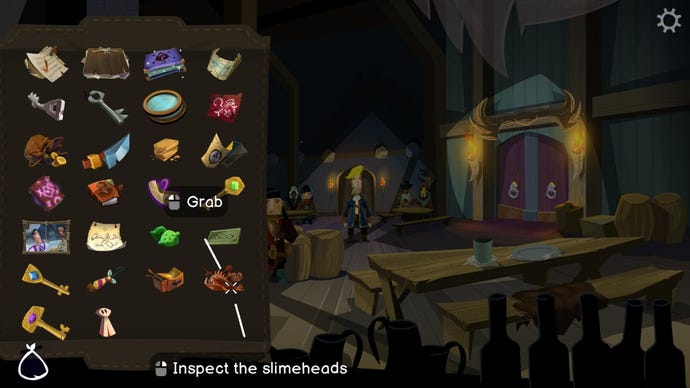
What's old is new again, and Return To Monkey Island gives Ron Gilbert and Dave Grossman another spin around the most famous piratical adventure series that video games has ever produced. Set in an unknown period after the events of The Curse Of Monkey Island, Return To Monkey Island recounts Guybrush Threepwood (a mighty pirate) and actually find the secret of Monkey Island, which he tried to do in the first game but was distracted by falling in love with Elaine Marley, and fighting zombie pirate LeChuck over who most wanted to marry her.
Most importantly, this is a robust and interesting point and click puzzle game that uses fun cartoony logic in it's myriad puzzles (and there are two difficulty settings, too). As a beloved video game series, Return has locations, characters and even jokes from the old games, but adds a new spin. It's meta (but not in an annoying way) about Guybrush's status as a famous adventurer, because ultimately things are changing and maybe he doesn't mean as much any more, but it's not alienating if you've never played these games. There's a lot that's new, too, and the quality of life changes, which include getting rid of the nine-verb menu and an extremely reactive hint system, make this a fantastic game for old fans, but also to onboard players who're a bit leery of point and click adventures in general.
9. Opus Magnum
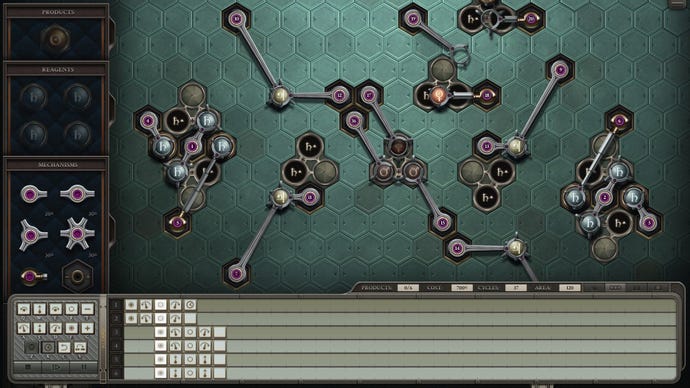
This is probably one of those puzzle games that secretly teaches you principles of computer coding, isn't it? In Opus Magnum you build automated machines whose repetetive movements will construct potions and poisons and what have you weirdnesses for you, an alchemist. There are programmable arms, tracks, pistons, and all manner of weird machines that you have to give meticulous instructions to. You can make arms pivot, pistons retract, control the exact amount they pivot when... It's overwhelming to start with, as you also have to take into account the timing, and how each of these elements move in concert with each other.
When you're faced with the challenged of putting two of a particular reagent together, in time for a third to be transformed and slotted on a rail so that they all come together, just as an arm is read to pick them up and drop them into the finished slot - and program it so the process can repeat without any of the mechanised bits lagging behind - you quickly see whether or not you're cut out for Opus Magnum. And that's a fairly simple puzzle. But there's a lot of open-ended flexibility here. If your machine works, it works. You can concentrate on making a beautiful, elegant machine with no parts wasted, but it still counts if you bodge together an awkward monstrosity. There's Steam Workshop integration, too, so you can struggle against challenges set from all over the world
8. The Talos Principle
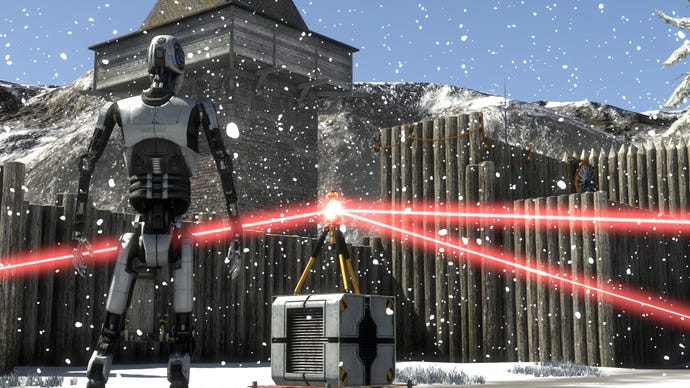
The Talos Principle blends the old, as you explore the ancient ruins of different civilisations, and the new. The hazards on your puzzling progress being high tech forcefields, floating robotic explosives, and automatic mounted gatling guns. These you can stall using Jammers on tripods, so much of your puzzling is getting your timing right and figuring out the logic of what will happen if you drop a certian barrier at a certain time. Later on you use light splitting crystals, which you can use to charge up doors in complex trails around the ruins, and weighted cubes on pressure pads The aim is to collect what are, basically, tetronimoes that allow you to open the doors to the next area.
They're good puzzles, but a large part of the reason that people remember The Talos Principle is the story around that - which I won't spoil, but has to do with free will and personhood (as a lot of puzzle games do, for some reason). You're solving these puzzles because you were told to by a voice which calls itself Elohim, and announces that it's your creator. This voice gets, honestly, kind of sinister, and you can find different clues telling you to defy or obey Elohim as you play. Whether you do or not is up to you - The Talos Principle has more than one ending - but the story isn't over either way, it seems, because Croteam say they're still working on a sequel.
7. Ctrl Alt Ego

Ctrl Alt Ego also appears on our best hacking games list, because it's both - although, if we're being honest, it's more straightforwardly a puzzle game than a hacking game. Actually, being super honest, it's not really a straightforward puzzle game. You're a sort of disembodied AI presence, able to flit hack into a flit between different machines. This includes, for example, cameras on data banks, allowing you to scope things out, but also little robits to trundle around, or even littler ones that can sneak into tunnels and have a 'bark like a dog' function.
The aim is, broadly, getting from one end of the 3D level to the next, but there are obstacles a-plenty in your way. Apart from physical obastacles like boxes and barriers, there are enemy robots who can tell if your droids are going where they shouldn't be, and daddy units that can dissolve matter. But fear not, because you can hack into them to dissolve and reposition things. Lateral thinking is encouraged and, indeed, essential, and if you die it's fine, cos you just go back to being disembodied and can have another go at it.
6. World Of Goo

This was our Game Of The Year in 2008, and it's still ruddy bloody good, as confirmed by Ollie when he revisited it in 2022. In fact "World Of Goo still offers more fun than nearly any puzzle game since" was the lofty praise he gave it, so it's surely worth a punt. In simple terms World Of Good is a physics-based bridge builder, crossed with Lemmings. You have to get your goo balls to the exit in the level, and you do that by building structures out of the goo themselves, building bridges, towers and pendulums out of their sticky, stretchy, non-Newtonian bodies.
The goo isn't (aren't?) that struturally sound, though, and are given to buckle under their own weight. Luckily there are different subspecies of goo, like pink ones that can float like helium and give you some lift, flammable goo, or green velcro goo so you can sort of rebuild structures mid-level. World Of Goo is both chaotic and elegant, and is still a marvellous achievement this many years later.
5. Unavowed

So you got possessed by a demon who murdered a bunch of people over the year they spent in your body. Mondays, am I right? But, freshly de-demoned, you join a group of supernatural cops who solve supernatural crimes in lush, detailed pixelart, and with a cast of amazing voice actors bringing it all to life. An escaped muse is going overboard on the inspiration thing, a baby has been kidnapped by faries - you know, magic cop stuff. These events all tie together in a story of rising darkness and so on, but though that's all good, the really impressive thing about Unavowed is how layered and complex the game is.
You can pick one of three origins (cop, actor or barkeep) which affects the characters you already know in the game, and how you approach problems. Your fellow Unavowed agents are also a varied bunch, including a medium accompanied by a ghost, and a fire mage. You pick two of them to accompany you on each level, and this, to affects what happens and how. Having the medium along means you can see and talk to any ghosts around the place; the fire mage... you know. An ex-cop can shoot a window out where someone else might break it. There are layers and layers of cleverness and complexity to peel back.
4. The Witness

The island of The Witness is very big, with a castle, an orchard, a severe-looking dock, a swamp, a lab, blossom trees, a desert bit, a forest, a mountain, a sort of treehouse - just, loads of weird bits. And each of these bits are full of puzzles - each area having a slightly different flavour of puzzle, though they're basically all getting a line from one side of a little input board to the other - teaching you the rules of how to solve things in The Witness. The orchard has puzzles that mirror the apple trees in front of you. Some maze puzzles need you to look at the shapes of shadows. The swamp has tetronimo shapes on it's puzzle boards, and the treehouse has white and dark stars. I didn't get on with either of those at all. Or the puzzles in the forest where you have to listen out for the tone of birdsong, those can, candidly, go absolutely to hell.
But many of the other puzzle types made complete sense to me. And you might hate the ones that I understood straight away. What makes The Witness so impressive is what makes it hard to describe: it's sort of every kind of puzzle game at once. And, on top of that, you're walking around a weird island, listening to cryptic voice notes and wondering who put all these machines there in the first place. Eventually, if you play it long enough, you can see there are puzzles all around you...
3. Portal

It was one of the best games full stop when it came out, and it still is. Portal is genuinely fantastic, with actual, very good environmental storytelling, one of the best antagonists ever immortalised in pixel form, and - yes - brilliant puzzles. You play a (in classive Valve style) voiceless and almost-nameless protagonist who wakes up in a testing facility, having, at some point, volunteered to be a test subject for Aperture Science and, at some point, going into cryo-sleep. Now, an undisclosed length of time in the future, you're woken by a suspiciously cheery AI and thrown into a series of testing chambers to complete physics based puzzles with a gun that fires portals.
The now-legendary GLaDOS grows more personal as she tests you, progressing through the levels between passive aggressive and homicidal with alarming rapidity. The testing facility is suspiciously empty, and eventually you start to see what's behind the pristine white walls. But the way Portal teaches you the rules of the game, how its physics and portals work, and the puzzles it presents you with, all have you thinking in an entirely different way by the end of the game. It's a classic for a reason.
2. Outer Wilds
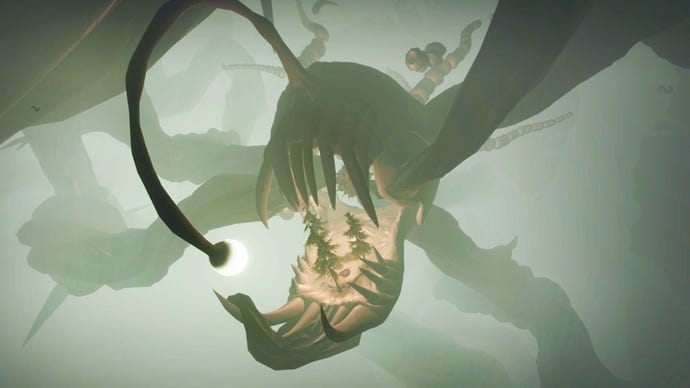
Outer Wilds is a unique puzzle game meets ramshackle space exploration. You wake up as the newest member of the Outer Wilds cosmonaut team, about to take your first solo flight (in a spaceship made of bins) away from your tiny home planet. It genuinely is tiny, too - it'd take you about four minutes to walk around it, but that's a precious amount of time to take, given that the sun in the centre of your tiny solar system goes supernova 22 minutes after you open your eyes.
Thank god that a magic statue in your town's museum gets you stuck in a timeloop, resetting the moment you die to start the day all over again. Using this ability, you can zoom around the different planets orbiting the sun and explore them - to within the limits of your oxygen meter, which is refilled either by trees or by returning to your ship. There's a lot to see, which is where the repeating loops come in. There are twins, one spilling sand into the other like an hourglass, revealing ruins on the first as the structures on the second are filled up. One is a puzzle planet. One is an exploded shell turned into a weird poket universe inside a multidimensional bramble. You can follow the sound of instruments to fellow scattered cosmonauts. The solution to Outer Wilds' puzzle is the universe.
1. Return Of The Obra Dinn

I think Return Of The Obra Dinn is this site's current favourite game - it is, after all, at the top of our top 100. It's hard to imagine what could unseat it from the number one spot on best puzzles, either. Return Of The Obra Dinn is a large game of what Eurogamer's Christian Donlan called "nautical murder sudoku" in his review. The titular Obra Dinn is a tall ship that went missing, and now it has reappeared with every living soul on board having died. Your job is a kind of magical insurance auditer armed with a Bernard's watch activated by death, which will show you the still-life moment of a person's death. You can walk freely around the scene, and daisy chain another death into more dioramas, all in a glorious monochromatic style mimicing much earlier games.
The challenge is to match up each body with the ship's manifest and a cause of death. This body belongs to the captain, who was shot by y, that sort of thing. Your choices are only revealed as correct once you've got three compleletely right at once. It's masterfully done, the more so because, as things progress, you notice some decidedly suspicious death options, including crushing and dismemberment... There's a point in Return Of The Obra Din where you open the cabin door, walk onto the deck, and realise the game has shifted gear. Encountering these deaths out of order, you eventually managed to put the whole story together, and it's one accompanied by screams, rending wood, and an absolutely banging soundtrack full of bells.






